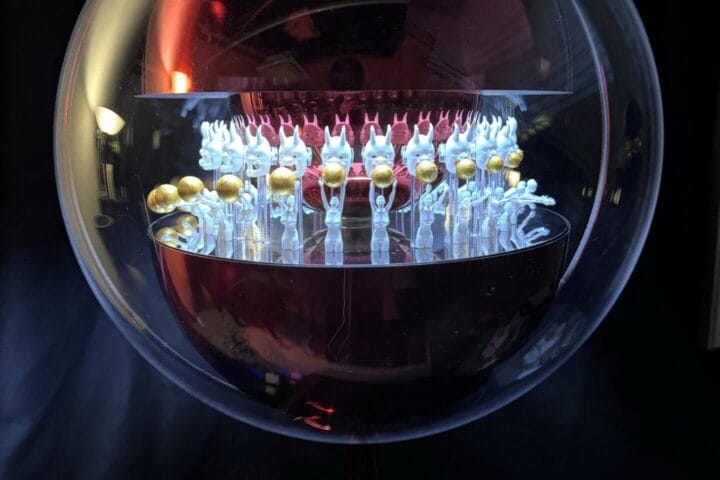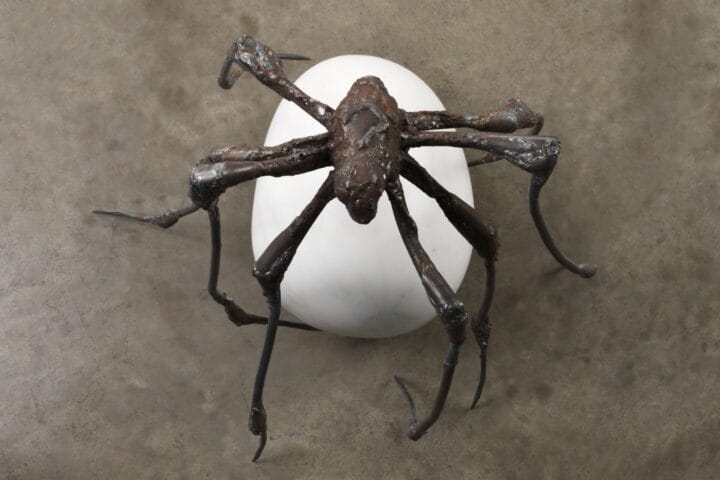1 December 2022 – A major new exhibition brings together for the first time over 150 paintings by an overlooked generation of 80 international women artists.
Whitechapel Gallery presents Action, Gesture, Paint: Women Artists and Global Abstraction 1940-70. The exhibition reaches beyond the predominantly white, male painters whose names are synonymous with the Abstract Expressionism movement, to discover the practices of numerous international women artists working with gestural abstraction in the aftermath of the Second World War.
The exhibition’s geographic breadth demonstrates that, while the Abstract Expressionism movement is said to have begun in the USA, artists all over the world were exploring similar themes of materiality, freedom of expression, perception and gesture in the mid-century period, from Art Informel to Arte Povera in Europe, and from calligraphic abstraction in East Asia to experimental, highly political practices in Central and South America, and the Middle East. The exhibition features well-known artists associated with the Abstract Expressionism movement, including American artists Lee Krasner (1908-1984) and Helen Frankenthaler (1928-2011), alongside lesser-known figures such as Mozambican-Italian artist Bertina Lopes (1924-2012) and South Korean artist Wook-kyung Choi (1940-1985). More than half of the works have never before been on public display in the UK.
At a time when the world was processing the anxieties of the Second World War and navigating a backdrop of deeply conflicted political climates, artists from across the world began to express their concerns in a new art that embraced personal and political freedom. The exhibition is arranged thematically, opening with Helen Frankenthaler’s four-metre-long abstract painting April Mood (1974). The opening section examines how artists were exploring the variable physical characteristics of paint, abandoning many of the accepted conventions around structure and composition. Accompanying Frankenthaler in this grouping is an untitled work from the 1960s evoking dissonance and tactility by Wook-kyung Choi, whose work has never before been shown in the UK, where white and blue stripes stage the spontaneous play of acrylic smatterings in green, yellow and red. Gestural abstraction was also beginning to emerge in South American countries as an anti-establishment vehicle of defiance in the face of prevailing social and political realities, and as a signpost of change. On display are two untitled works from 1961 by Marta Minujín (b. 1943, Argentina), who worked on the floor using sand, lacquer, chalk and carpenter’s glue to form highly textured surfaces that, once set, were coated with thick layers of paint.
The exhibition goes on to examine the ways in which artists were using painterly expression to explore themes of mythology and symbolism. Lee Krasner’s work Bald Eagle (1955) returns to Whitechapel Gallery for the first time since her retrospective in 1965. The work describes organic elements in autumnal colours, which, though recognisable, reject assimilation, exploring ideas of metamorphosis and symbolism. Painted one year later in 1956, an intimate untitled work by Iranian artist Behjat Sadr (1924-2009) offers a more solemn experience of these themes, where a linear interplay of oppositional colours emerges from a dark background, evoking a meaningful and personal calligraphy around a central heart of red. Bertina Lopes’ gestural work presents not only Mozambican iconography but also political events. On display are two works from 1969 by Lopes, made after fleeing Mozambique to Portugal and then Rome, as her anti-fascist and anti-colonialist views strengthened, and the political situation in Mozambique became more tumultuous. The American artist Jay DeFeo’s (1929-1989) work was inspired by the decimation of Italian and French populations in the postwar period. In Torso (1952), DeFeo alludes to human expression being forcefully removed from the history of art, with a body that appears to be compromised, imprisoned and compacted by the virulence of her brush strokes.
The third grouping brings together works by artists which, through explorations of the self, demonstrate an immediacy, where pure emotion appears to be translated directly onto the canvas. Included is The Illusion of Solidity (c. 1945) by Ukrainian-born artist Janet Sobel (1893-1968), who arguably informed Jackson Pollock’s own approach to dripped compositions. Clouds of emotive reds, yellows, greens and blues are overlayed with an evolving mass of pink and black swirls scored into the paint, both a surrealist daydream and existential creation. In contrast, Spanish artist Juanca Francés’(1924-1990) Numero 8 (1958) implies existential conflict through a sombre register of shades, a white base corrupted by charcoal shadows and singed by a textured black, intended as a protest against Franco and fascist Spain. Also on display is Pequeña nada [Little Nothing] (1959) by Venezuelan artist Mercedes Pardo (1921-2005), an intimate and existential painting which seeks to express ‘otherness’ and absence in a surprising register of vibrant colour.
In the fourth grouping artists whose abstract paintings and gestural brushstrokes had strong associations with dance, music and other forms of performance are brought together. The American artist Judith Godwin’s (1930-2021) sweeping gestures interspersed with angled shapes akin to the performers of modern dance were influenced by her frequent attendance at performances by the revolutionary American dancer and choreographer Martha Graham (1894-1991). On display will be Black Pagoda (1959), in which the dominant element is an angled form that finds similarities with the dramatic contortions assumed by Graham and her dancers. Toko Shinoda (1913-2021, Japan), became the first prominent woman artist in Japan and was among the few Asian artists to become associated with Abstract Expressionism. Shinoda radicalised the traditional medium of calligraphy by pushing abstraction and dynamism to the extreme. On display are a series of prints which demonstrate how Shinoda, through rhythmic lines and gestures, crossed the boundaries between East Asian calligraphy and Western-style modern art, and in doing so invented her own field.
The final part of the exhibition considers how artists turned to their surroundings and environments as subject matter, including townscapes, seascapes and rural landscapes. The 1964 work A Touch of Red by Chinyee (b. 1929, China) explores the notion of the sublime, narrating a formless atmospheric landscape in green with bursts of bright colour. Meanwhile, the forms of Polish artist Janice Biala’s (1903-2000) intimate interior Yellow Still Life (c. 1955) combine into an unsettling composition, as each object is highlighted by a bright yellow colour. Shown in the UK for the first time are two works from 1967 by Ukrainian-born artist Lea Nikel (1918-2005), which, through their vibrancy, capture the local light and colour of Israel, where she spent time in the 1950s. The last work in the exhibition is Swedish Landscape (c. 1960) by Swedish artist Britta Ringvall (1899-1983), one of the least known artists in the entire presentation, a quiet work depicting a rural landscape through a red curtained window.
Laura Smith, Curator, Whitechapel Gallery said:
“Action, Gesture, Paint reveals how these international artists were redefining artistic practice as an immersive arena for action, process and consciousness, drawing on the avant-garde movements of Expressionism and Surrealism. We also see how they endowed the ideas and methodologies of the movement with their own specific cultural, political and subjective dimensions. Their paintings were regarded not as images but as events, and they were an important catalyst for changing ideas around aesthetics, poetry, philosophy and politics in their distinct and particular regions.”
Notes to Editors
- Action, Gesture, Paint: Women Artists and Global Abstraction 1940-70 runs from 9 February – 7 May 2023.
- The exhibition has been shaped by a curatorial advisory board including Iwona Blazwick, Margaux Bonopera, Bice Curiger, Christian Levett, Erin Li, Julia Marchand, Joan Marter, Laura Rehme, Agustin Perez Rubio, Elizabeth Smith, Laura Smith, Candy Stobbs and Christina Vegh.
- Organised by Whitechapel Gallery in collaboration with the advisory board, the exhibition will travel to France and Germany (Whitechapel Gallery, London, UK, 9 February – 7 May 2023, Fondation Vincent Van Gogh, Arles, France, 3 June – 22 October 2023, Kunsthalle Bielefeld, Germany, 2 December 2023 – 3 March 2024).
- List of exhibited artists: Mary Abbott, Etel Adnan, Maliheh Afnan, Ruth Armer, Gillian Ayres, Ida Barbarigo, Noemi di Benedetto, Anna Eva Bergman, Bernice Bing, Sandra Blow, Dusti Bongé, Chinyee, Wook-kyung Choi, Jay DeFeo, Martha Edelheit, Amaranth Ehrenhalt, Lifang, Asma Fayoumi, Lilly Fenichel, Perle Fine, Else Fischer-Hansen, Elna Fonnesbech-Sandberg, Juana Francés, Helen Frankenthaler, Sonia Gechtoff, Judith Godwin, Gloria Gómez-Sanchez, Elsa Gramcko, Sarah Grilo, Grace Hartigan, Lilian Holt, Buffie Johnson, Yuki Katsura, Helen Khal, Elaine de Kooning, Lee Krasner, Bice Lazzari, Bertina Lopes, Margaret Mellis, Marta Minujín, Joan Mitchell, Aiko Miyawake, Yolanda Mohalyi, Nasreen Mohamedi, Emiko Nakano, Lea Nikel, Tomie Ohtake, Fayga Ostrower, Mercedes Pardo, Charlotte Park, Betty Parsons, Pat Passlof, Alice Rahon, Carol Rama, Marie Raymond, Judit Reigl, Deborah Remington, Britta Ringvall, Erna Rosenstein, Behjat Sadr, Nadia Saikali, Zilia Sánchez, Fanny Sanín, Sarah Schumann, Ethel Schwabacher, Miriam Schapiro, Sonja Sekula, Toko Shinoda, Sylvia Snowden, Janet Sobel, Vivian Springford, Franciszka Themerson, Alma Thomas, Yvonne Thomas, Hedwig Thun, Nína Tryggvadóttir, Elsa Vaudrey, Maria Helena Vieira da Silva, Michael West.
- The exhibition has been generally supported by the Terra Foundation for American Art, with additional support from The Levett Collection, Be Flaneur, Helen Frankenthaler Foundation, Soo & Jonathan Hitchin, Richard Saltoun Gallery, and Atelier Ellis.
About Whitechapel Gallery
For over a century the Whitechapel Gallery has premiered world-class artists from modern masters such as Pablo Picasso, Jackson Pollock, Mark Rothko, Frida Kahlo, Eduardo Paolozzi and Hannah Höch to contemporaries such as Zarina Bhimji, Sophie Calle, William Kentridge and Michael Rakowitz. Its historic campus houses exhibitions, artist commissions, collection displays, historic archives, education resources, inspiring art courses, talks and film screenings, the Townsend dining room and the Koenig Bookshop. It is a touchstone for contemporary art internationally, plays a central role in London’s cultural landscape and is pivotal to the continued growth of the world’s most vibrant contemporary art quarter.
Whitechapel Gallery
77-82 Whitechapel High St, London E1 7QX, United Kingdom












